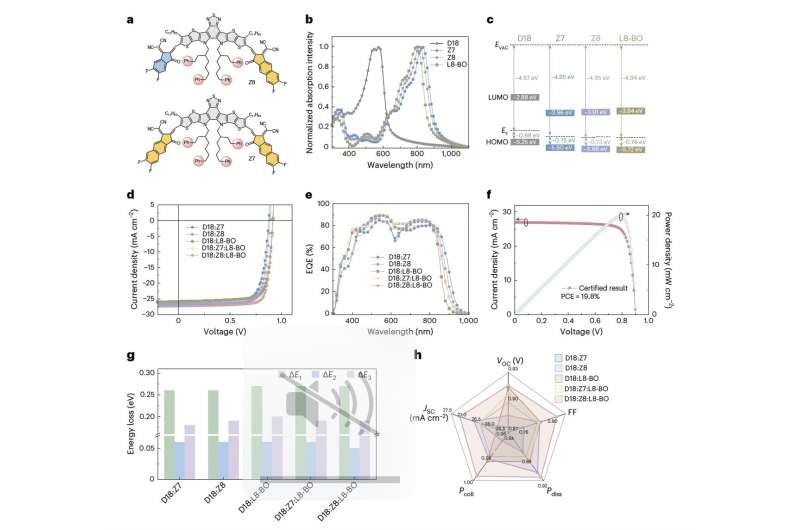New non-fullerene acceptor helps achieve 20.2% efficiency in organic solar cells
In recent years, engineers have introduced a wide range of photovoltaic (PV) solutions that could facilitate the sustainable generation of electricity worldwide. These include organic solar cells (OSCs), PV devices that use organic molecules or polymers to convert sunlight into electrical power.
These solar cells could have notable advantages, including high flexibility, lighter weight and lower fabrication costs. However, their power conversion efficiencies (PCEs) remain significantly lower than those of silicon-based solar cells.
Researchers at the Chinese Academy of Sciences and Beijing Normal University recently designed a new asymmetric non-fullerene acceptor (i.e., a material that can accept and transport electrons) that could improve the efficiency of OSCs. This material, introduced in a paper published in Nature Energy, has various advantageous optoelectronic properties, including a high photoluminescence quantum yield (PLQY) and delocalized excitons.
“For organic solar cells (OSCs), bridging the gap with Shockley–Queisser limit necessitates simultaneously reducing the energy loss for a high open-circuit voltage, improving light utilization for enhanced short-circuit current density and maintaining ideal nanomorphology with a high fill factor through molecular design and device engineering,” Yuanyuan Jiang, Shaoming Sun, and their colleagues wrote in their paper.
“We design and synthesize an asymmetric non-fullerene acceptor (Z8) featuring tethered phenyl groups to establish an alloy acceptor in ternary OSCs.”
The asymmetric non-fullerene acceptor designed by Jiang, Sun and their colleagues is characterized by phenyl-substitution side chains. Its remarkable optoelectronic properties could reduce non-radiative energy losses in solar cells, while promoting the efficient generation and transfer of electrical charge.
“The asymmetric structure minimizes non-radiative energy loss and charge recombination owing to delocalized excitons,” Jiang, Sun and their colleagues wrote. “The phenyl-substituted alkyl side chain impacts on the intermolecular interactions, improving the film nanomorphology with efficient exciton dissociation and reduced charge recombination.”
To assess their newly designed acceptors, the researchers used them to fabricate single-junction OSCs. The resulting solar cells achieved highly promising efficiencies of 20.2% (certified 19.8%) which compares favorably to other OSCs developed in recent years.
“Through theoretical calculations, we examine the overall distribution of photon and carrier losses and analyze the potential for improvement on open-circuit voltage, short-circuit current density and fill factor, providing rational guidance for further development of the OSC performance,” Jiang, Sun and their colleagues wrote.
While the results attained by the team’s acceptors are encouraging, they still do not compare to the efficiencies reported in silicon-based and various other non-organic PV technologies. In their next studies, Jiang, Sun and their colleagues plan to continue designing materials that could help to minimize photon and carrier losses in OSCs.
Their efforts could contribute to the development of increasingly efficient and scalable OSCs, which could be realistically deployed in real-world settings. Concurrently, their work could inspire others in the PV research community to design similar non-fullerene acceptors aimed at reducing both photon and carrier losses in cells.
More information:
Yuanyuan Jiang et al, Non-fullerene acceptor with asymmetric structure and phenyl-substituted alkyl side chain for 20.2% efficiency organic solar cells, Nature Energy (2024). DOI: 10.1038/s41560-024-01557-z
© 2024 Science X Network
Citation:
New non-fullerene acceptor helps achieve 20.2% efficiency in organic solar cells (2024, July 2)
retrieved 2 July 2024
from https://techxplore.com/news/2024-07-fullerene-acceptor-efficiency-solar-cells.html
This document is subject to copyright. Apart from any fair dealing for the purpose of private study or research, no
part may be reproduced without the written permission. The content is provided for information purposes only.

Comments are closed